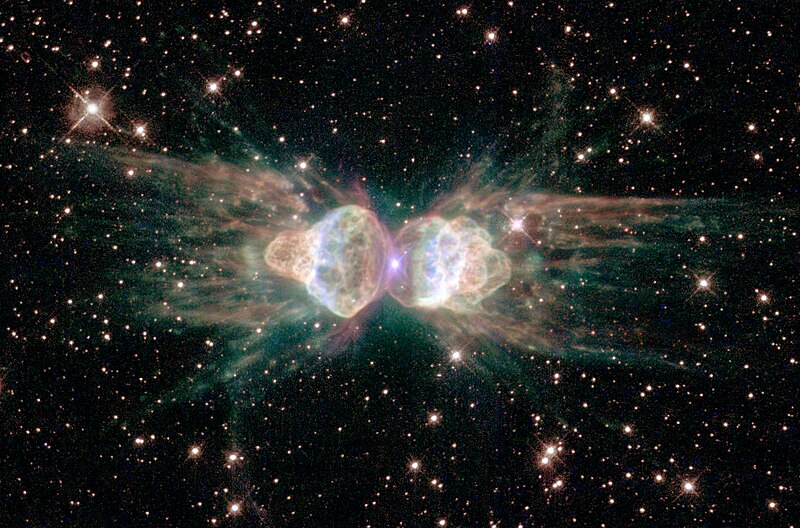പ്രമാണം:Ant Nebula.jpg

ഈ പ്രിവ്യൂവിന്റെ വലിപ്പം: 800 × 528 പിക്സലുകൾ. മറ്റ് റെസലൂഷനുകൾ: 320 × 211 പിക്സലുകൾ | 640 × 423 പിക്സലുകൾ | 1,072 × 708 പിക്സലുകൾ.
പൂർണ്ണ വലിപ്പം (1,072 × 708 പിക്സൽ, പ്രമാണത്തിന്റെ വലിപ്പം: 1.14 എം.ബി., മൈം തരം: image/jpeg)
പ്രമാണ നാൾവഴി
ഏതെങ്കിലും തീയതി/സമയ കണ്ണിയിൽ ഞെക്കിയാൽ പ്രസ്തുതസമയത്ത് ഈ പ്രമാണം എങ്ങനെയായിരുന്നു എന്നു കാണാം.
| തീയതി/സമയം | ലഘുചിത്രം | അളവുകൾ | ഉപയോക്താവ് | അഭിപ്രായം | |
|---|---|---|---|---|---|
| നിലവിലുള്ളത് | 01:04, 1 ഫെബ്രുവരി 2008 |  | 1,072 × 708 (1.14 എം.ബി.) | Papa November | Full res version from source |
| 01:01, 1 ഫെബ്രുവരി 2008 |  | 1,072 × 708 (148 കെ.ബി.) | Papa November | Uploaded full resolution image from source | |
| 14:30, 29 ജനുവരി 2008 |  | 600 × 362 (69 കെ.ബി.) | Nk | {{Information |Description=The Ant planetary nebula (Menzel 3 or Mz 3). STScI-PRC2001-05 This NASA/ESA Hubble Space Telescope image reveals the ant's body as a pair of fiery lobes protruding from a dying, Sun-like star. Though approaching the violence o |
പ്രമാണത്തിന്റെ ഉപയോഗം
താഴെ കാണുന്ന താളിൽ ഈ ചിത്രം ഉപയോഗിക്കുന്നു:
പ്രമാണത്തിന്റെ ആഗോള ഉപയോഗം
താഴെ കൊടുത്തിരിക്കുന്ന മറ്റ് വിക്കികൾ ഈ പ്രമാണം ഉപയോഗിക്കുന്നു:
- af.wikipedia.org സംരംഭത്തിലെ ഉപയോഗം
- an.wikipedia.org സംരംഭത്തിലെ ഉപയോഗം
- ar.wikipedia.org സംരംഭത്തിലെ ഉപയോഗം
- ar.wikiversity.org സംരംഭത്തിലെ ഉപയോഗം
- arz.wikipedia.org സംരംഭത്തിലെ ഉപയോഗം
- ast.wikipedia.org സംരംഭത്തിലെ ഉപയോഗം
- ba.wikipedia.org സംരംഭത്തിലെ ഉപയോഗം
- bg.wikipedia.org സംരംഭത്തിലെ ഉപയോഗം
- bjn.wikipedia.org സംരംഭത്തിലെ ഉപയോഗം
- bn.wikipedia.org സംരംഭത്തിലെ ഉപയോഗം
- br.wikipedia.org സംരംഭത്തിലെ ഉപയോഗം
- ca.wikipedia.org സംരംഭത്തിലെ ഉപയോഗം
- cbk-zam.wikipedia.org സംരംഭത്തിലെ ഉപയോഗം
- ce.wikipedia.org സംരംഭത്തിലെ ഉപയോഗം
- cs.wikipedia.org സംരംഭത്തിലെ ഉപയോഗം
- de.wikipedia.org സംരംഭത്തിലെ ഉപയോഗം
- en.wikipedia.org സംരംഭത്തിലെ ഉപയോഗം
- Astronomy
- Norma (constellation)
- Talk:Outline of physical science
- Mz 3
- List of planetary nebulae
- Portal:Astronomy/Picture/May 2005
- Portal:Astronomy/Picture/August 2005
- Portal:Astronomy/Picture/17 May 2005
- Portal:Astronomy/Picture/10 August 2005
- Portal:Astronomy/Picture/Week 01 2006
- User:King Zebu
- User:Exoplanetaryscience/sandbox
- en.wikinews.org സംരംഭത്തിലെ ഉപയോഗം
- en.wikiversity.org സംരംഭത്തിലെ ഉപയോഗം
ഈ പ്രമാണത്തിന്റെ കൂടുതൽ ആഗോള ഉപയോഗം കാണുക.


